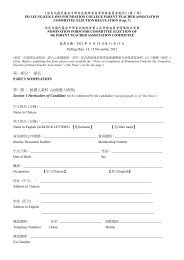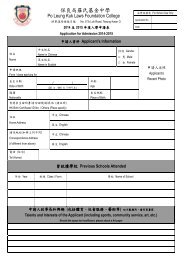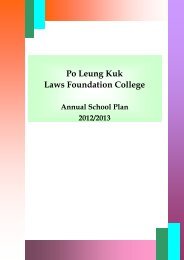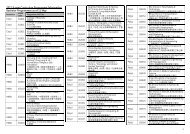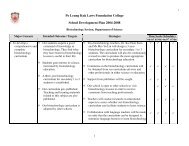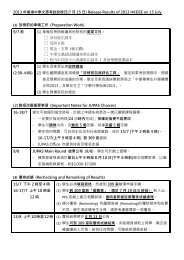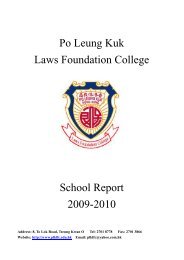Scheme of Work 2005-2006 - Po Leung Kuk Laws Foundation College
Scheme of Work 2005-2006 - Po Leung Kuk Laws Foundation College
Scheme of Work 2005-2006 - Po Leung Kuk Laws Foundation College
You also want an ePaper? Increase the reach of your titles
YUMPU automatically turns print PDFs into web optimized ePapers that Google loves.
2First SemesterNo. <strong>of</strong> Topic Learning objectives Teaching contents Teaching activities Generic Teaching aidslesson(s)skills1 Prefixes andSuffixes To be able to dissectbiological terms into partswith prefixes and suffixes To be able to find themeaning <strong>of</strong> different prefixesand suffixes in differentchannels such as the internet The prefixes and suffixes inbiology The concept for word dissectionin biology The importance to understandprefixes and suffixes in biology Internet resources aboutprefixes and suffixes in biology(e.g.http://biology.about.com/library/ Competition / challengingexercises about prefixesand suffixes(http://biology.about.com/library/weekly/blpre1q.htm)3, 5, 9 <strong>Work</strong>sheet <strong>Po</strong>wer<strong>Po</strong>intslides Biologyprefixes andsuffixes(http://biology.about.com/library/prefix/blprefix.htm )prefix/blprefix.htm)1 Basicchemistry inlife - Atoms To revise the particle theorylearnt in the secondary 1Integrated Science curriculum To understand particles aremade up <strong>of</strong> atoms. To know that an element ismade up <strong>of</strong> one type <strong>of</strong> atoms To know that a compound ismade up <strong>of</strong> more than onetype <strong>of</strong> atoms To know the terms: organic Particle theory Periodic table The concept <strong>of</strong> elements The concept <strong>of</strong> compounds Examples <strong>of</strong> elements andcompounds Examples <strong>of</strong> biologicalcompounds Examples <strong>of</strong> organic andinorganic compounds The use <strong>of</strong> Students will see differenttypes <strong>of</strong> chemicals so thatthey will have more ideasabout elements andcompounds.5, 9 <strong>Work</strong>sheet <strong>Po</strong>wer<strong>Po</strong>intslides ChemicalGeneric Skills: 1 – Collaboration Skills 2 – Communication Skills 3 – Creativity 4 – Critical Thinking Skills 5 – Information and Technology Skills 6 – Numeracy Skills 7 – Problem-solvingSkills 8 – Self-management Skills 9 – Study Skills
3and inorganic compoundshttp://www.wikipedia.org to To realize that biologicalsearch for the information aboutcompounds such as celldifferent types <strong>of</strong> elements andmembrane is made up <strong>of</strong> C,compoundsH, O and N atoms mainly To develop self-learningskills to search for theinformation about differenttypes <strong>of</strong> elements andcompounds2 Basic To be able to get information How to read the Periodic table Experiment (1): Students1, 6, 7 <strong>Work</strong>sheetchemistry inabout molar mass from the(mainly the atomic mass <strong>of</strong>will prepare 0.9 % saline <strong>Po</strong>wer<strong>Po</strong>intlife - Moleperiodic tableelements) Experiment (2): Studentsslides To understand that 1 mole =nearly 6.022 x 10 23 1 mole = nearly 6.022 x 10 23 Calculation about “mole”: somewill make a beaker <strong>of</strong>sugar solution which Experimentalresources: To be able to calculate molarexamples <strong>of</strong> elements andconcentration is similar tosugar andmass and the number <strong>of</strong>compounds. (e.g. 1 mole <strong>of</strong> H 2 Othe sugar content in theNaClmolescontains 2 moles <strong>of</strong> H and 1urine <strong>of</strong> diabetics’ patients To realize the importance <strong>of</strong>mole <strong>of</strong> O atoms)this topic in daily life Molar mass The relationship between thenumber <strong>of</strong> moles and molarmass Daily life examples: Preparation<strong>of</strong> 0.9 % saline, and sugarGeneric Skills: 1 – Collaboration Skills 2 – Communication Skills 3 – Creativity 4 – Critical Thinking Skills 5 – Information and Technology Skills 6 – Numeracy Skills 7 – Problem-solvingSkills 8 – Self-management Skills 9 – Study Skills
4content in the urine <strong>of</strong> diabetics’patients.3 Basic To understand the concept The concept <strong>of</strong> concentration Experiment (1): Students1, 4, 6, <strong>Work</strong>sheetchemistry in<strong>of</strong> concentration (more(more particles in a volume)will study which7, <strong>Po</strong>wer<strong>Po</strong>intlife –particles in a volume => more The terms: concentrated andconcentration <strong>of</strong> NaCl isslidesConcentrationconcentrated)dilutedthe best for green bean Experimental(Molarity) To be able to deal with Mathematical equation aboutgermination orresourcesmathematical questionsMolarity (It is not suggested Experiment (2): Studyrelated to molaritythat the teacher only introducewhich concentration <strong>of</strong> To develop skills to conductthe equation without explainingNaCl solution canexperiments and researchthe concept and meaning <strong>of</strong> thepreserve milk orequation.) Experiment (3): Study Calculation about Molaritywhich concentration <strong>of</strong> Experiment (1): Study greenNaCl solution can kill redbean germination in differentworms orconcentrations <strong>of</strong> NaCl solution Experiment (4): Study Experiment (2): Study whichwhich concentration <strong>of</strong>concentration <strong>of</strong> NaCl solutionbleach solution can kill redcan preserve milkworms Experiment (3): Study whichconcentration <strong>of</strong> NaCl solution(Through doing thesecan kill red wormsexperiment, students will Experiment (4): Study whichacquire a concrete skill toconcentration <strong>of</strong> bleach solutiondeal with molarity problems.)can kill red wormsGeneric Skills: 1 – Collaboration Skills 2 – Communication Skills 3 – Creativity 4 – Critical Thinking Skills 5 – Information and Technology Skills 6 – Numeracy Skills 7 – Problem-solvingSkills 8 – Self-management Skills 9 – Study Skills
5Second semesterNo. <strong>of</strong>lesson(s)Topic Learning objectives Teaching contents Teaching activities Genericskills5 Cellular To realize the location, The location, functions and Experiment (1): Students 1, 2, 3,organelles functions and structure <strong>of</strong> structure <strong>of</strong> cellular organelles will stain cellular 4, 5, 6,cellular organelles.including nucleus,organelles in plant cells 7, 9 To acquire skills to conduct mitochondria, endoplasmic (e.g. onion cells)microscopic staining <strong>of</strong> cells reticulum, Golgi apparatus and Experiment (2): Studentsand cellular organelles chloroplastswill study the changes <strong>of</strong> To develop research skills The structure <strong>of</strong> cell membrane organelles when the cells Microscopy on cellularare exposed toorganellesunfavorable conditions Drugs and chemicals which can (e.g. 1: plant cells are putdestroy different types <strong>of</strong>in extremely hypertonicorganellessolution and students willstudy the changes <strong>of</strong>nucleus, mitochondria andER)(e.g. 2: plant cells are putunder UV light conditionand students will study thechanges in nucleus.)(e.g. 3: Students will lookTeaching aids <strong>Work</strong>sheet <strong>Po</strong>wer<strong>Po</strong>intslides ExperimentalresourcesGeneric Skills: 1 – Collaboration Skills 2 – Communication Skills 3 – Creativity 4 – Critical Thinking Skills 5 – Information and Technology Skills 6 – Numeracy Skills 7 – Problem-solvingSkills 8 – Self-management Skills 9 – Study Skills
6for a method to destroycellular organelles andstudy their changes bymicroscopy.) Creative writing: Studentswill write a article todescribe the importance <strong>of</strong>organelles5 Plant tissue To understand the importance Plant physiology (plant Experiment (1): Students1, 2, 3, <strong>Work</strong>sheetcultureto develop plant tissue culturestructure and plantwill start aseptic plant4, 5, 6, <strong>Po</strong>wer<strong>Po</strong>int To know the plant structuredevelopment)tissue culture by7, 8, 9slidesand development (basic plant Knowledge about plant tissuegerminating seeds in agar Experimentalphysiology)culturesupplemented withresources To develop practical skills The uses and application <strong>of</strong>nutrients for plant growthculture plant tissuesplant tissue culture (e.g. Experiment (2): Students To develop research skillsagriculture)will culture pieces <strong>of</strong> plant To acquire searching skills to Sterilization techniques (e.g.stem, root and leafdeal with problemsautoclave and asepticaseptically.techniques) Experiment (3): Students Online resources for plant tissuewill study the bestcultureconditions for plant tissueculture10 DNA and its To develop an attitude to Discovery <strong>of</strong> DNA Presentation (by role1, 2, 3, <strong>Work</strong>sheetimportanceappreciate the success <strong>of</strong> Structure <strong>of</strong> DNA (shape, lengthplay): Students will4, 5, 6, <strong>Po</strong>wer<strong>Po</strong>intGeneric Skills: 1 – Collaboration Skills 2 – Communication Skills 3 – Creativity 4 – Critical Thinking Skills 5 – Information and Technology Skills 6 – Numeracy Skills 7 – Problem-solvingSkills 8 – Self-management Skills 9 – Study Skills
7scienceand arrangement)present the success and7, 8, 9 slides To learn the scientific Structure <strong>of</strong> DNA (ATCG)scientific attitude <strong>of</strong> some Experimentalmethods from the scientists The concept <strong>of</strong> a gene andscientists who discoveredresourcesdiscovering DNAhereditary (How can DNADNA To learn how information istransfer information?) Experiment (1): Studentsstored in DNA Mendel’s theory aboutwill study their family To acquire knowledge abouthereditaryabout genetic diseasesgenetic diseases Some examples <strong>of</strong> geneticusing a tree diagram To know the advancement <strong>of</strong>diseases Experiment (2): StudentsDNA technology The specificity <strong>of</strong> DNA and itswill conduct DNA To learn how to apply DNAimportancefingerprinting to study thetechnology in daily life Current DNA technologysimilarity and differences Human genome projectin terms <strong>of</strong> DNA Online resources about genefingerprintssequencesGeneric Skills: 1 – Collaboration Skills 2 – Communication Skills 3 – Creativity 4 – Critical Thinking Skills 5 – Information and Technology Skills 6 – Numeracy Skills 7 – Problem-solvingSkills 8 – Self-management Skills 9 – Study Skills


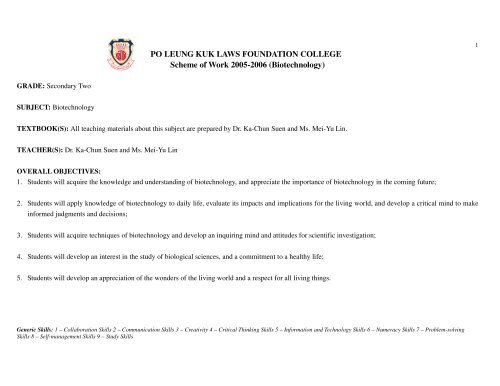

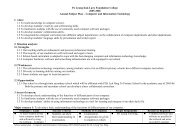
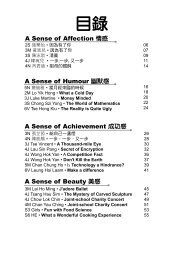
![Page 1 Page 2 Page 3 ããä¸çæ¯å¹³çãTheWorIdiSf]at)ã ä½è
湯馬 æ¯ ...](https://img.yumpu.com/49083939/1/184x260/page-1-page-2-page-3-aaacaeacatheworidisfata-a-1-2-eaee-ae-.jpg?quality=85)
